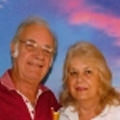
Weather Station Activities for Seniors
Found In: ›Activities ›Articles ›For Men ›Outdoor ›One-on-One ›World Meteorological Day ›International Men's Day

Golden Carers has 1000s of activities and resources for senior care.
Why is the weather such an inherent part of conversations in so many countries?
It could be because it is ever-changing, or because it affects everybody, or maybe just because it is an interesting and harmless topic of conversation; whether among friends or strangers. Perhaps it is for all of these reasons.
Not every culture has this habit of discussing the weather; in Arab countries for instance only extreme weather fuels talk about the weather.
The Weather as a Hobby
Given our enthusiasm for the weather in much of the Western world, it is not surprising that many people enjoy keeping track of the weather as a hobby.
In the long years I worked with seniors I encountered a number of them with an intriguing devotion to ‘checking the weather gauge’.
It is an absorbing activity suitable for any time of the year. Perhaps you have some residents who would enjoy this project as well.
An Engaging & Stimulating Activity for Seniors
Meteorology is the study of atmospheric changes: rainfall, temperature, relative humidity and other elements of nature. Gadgets to measure these things can be found at your local hardware store at very affordable prices.
Of course you could purchase a modern, digital Weather Station gadget which measures all of the above in an instant but I think this would defeat the purpose. The goal is to provide a stimulating project for some curious and interested residents.
Measuring and recording rainfall and fluctuations in temperature will engage residents and bring a great deal of satisfaction.
Announce the idea at your monthly ‘Residents Meeting’ to find interested and suitable contenders or try and excite some of the loners at your facility into participating in this project while conducting room visits.
Starting a Weather Station
Consider the rain gauge and the weather thermometer.
Rain gauge
A rain gauge to monitor rainfall is inexpensive (starting at $6). Alternatively a homemade rain gauge is as easy as placing a plastic jar outdoors to collect rain and then sticking a ruler next to the jar to see how high the precipitation reaches.
Materials:
- A rain gauge
- A pencil/pen
- A daily note-book to record your readings and data.
Instructions:
- Place rain gauge outdoors
- Measure rainfall every 24 hours at the same time.
- Write your findings in the note-book.
- Every month (bi-monthly or quarterly) make a report graph from the note-book data (you may use the supplied Golden Carers graph; either in Fahrenheit or Degrees) and share it with others or place in a prominent place for others to see and wonder.
Thermometer
The popular combined Maximum-Minimum thermometer which indicates temperature reached over the course of 24 hours is the most suitable. This U-shaped thermometer has temperature scales expressed in degrees Celsius (ºC) or Fahrenheit (ºF) and can be bought from as little as $12.
Monitoring the daily temperature has some advantages; it can help you determine how to dress appropriately as well as avoid going out when the temperature is extreme.
Materials:
- A weather thermometer (Maximum-minimum)
- A pencil/pen
- A daily note-book to record your readings and data.
Instructions:
- Place thermometer in a shaded area with good ventilation for best results
- Check temperature daily and record them in the notebook.
- At the end of each month (bi-monthly or quarterly), make a graph (you may use the supplied Golden Carers graph; either in Fahrenheit or Degrees) and share information with others or place in prominent place where others can see.
Reporting
How often the report is made is up to staff and the resident in charge of the thermometer or rain gauge. The above is an example only.
Read manufacturer's instructions with residents before starting the project and make sure they understand what to do.
Visit residents in charge of projects once in a while for support and encouragement.
You may expand the weather station in the future with a:
- Barometer (to measure atmospheric pressure)
- Psychrometer (to measure relative humidity)
- Wind Vane (to measure wind direction).
You may find that residents involved in taking care of the weather gadgets are very proud and happy to be able to assist staff.
Sharing Weather Reports
The monthly report findings should be shared with others; use it to turn the occasion into an activity. Read and compare the rainfall with the temperature (noting that when it rains the temperature falls).
Weather Reminiscing for Seniors
Here are a few ideas to carry on with this theme:
- Reminisce about the days when the weather was predicted by reading the signs of nature and superstitions.
- Animals/birds can also predict the weather. If you have country people or farmers among the residents they will be able to share their stories.
- Ask if anyone remembers what Native American Indians do to provoke rain? Also ask participants if they think the weatherman has an easy task.
- Read and discuss 'Old ways to predict the weather'
- Play the 'Weather Events' game.
- Read 'Weather Sayings and Poems' and ask participants to add their own.
- Hand out a 'Weather Word Search' to those interested.
Old Fashioned Ways to Predict the Weather
- If the moon has a ring around it; rain (or snow) will come anytime in the next three days.
- A rainbow in the west means rain is on its way. A rainbow in the east means dry weather is on its way.
- Spiders come down from their webs before the rain.
- The more rain, the louder the noise made by frogs.
- If you take a deep breath and smell compost or earth, moisture is coming soon.
- If cattle lie down in a group in the fields, a severe storm is sure to come.
- If your knee joints are hurting, rain is coming.
- If the bull leads the cows to pasture, expect rain; if the cows precede the bull, the weather will be uncertain.
- Wolves always howl more before a storm.
- Bats flying late in the evening indicate fair weather.
Game: Weather Events
Gather two groups of people to challenge each other to come up with the most weather events they can think of.
Use a whiteboard or a large piece of paper, divide it in the middle with a line and write down the list for each group.
The group with the most weather events wins. Here is a list of some weather events for you to jog their memories.
DROUGHT – FIRE HAZZARD – TORNADOS – TYPHOONS – HAIL – MIST – HUMID – CLOUDY – SUNNY - STORMY – WET – DRY – HURRICANES – AVALANCHE – THUNDER SNOW – RAINY – COLD – HOT – SAND STORMS – WINDY – SLEET - BLIZZARD – FOGGY – SNOW – HEATWAVE – ICE STORM – DUST STORM – CYCLONE – THUNDERSTORM - SUN SHOWER – MORNING GLORY CLOUD
Sayings and Poems About the Weather
- “Swallows flying near the ground
mean a storm will come around”.
- “If smoke hangs low,
watch out for a blow.”
(Meaning low air pressure can prevent campfire smoke from rising very high.)
- “When the grass is dry at night,
look for rain before light,
when the grass is dry at morning light,
look for rain before the night.”
- “When windows won’t open, and the salt clogs the shaker,
the weather will favour the umbrella maker!”
- “If woolly fleeces deck the heavenly way,
be sure no rain will mar a summer’s day.”
- Onion skins very thin
Mild winter coming in:
Onion skins thick and tough
Coming winter cold and rough
- A summer fog for fair,
A winter fog for rain
A fact most everywhere,
In valley or on plain
-
Whether the weather be fine
Or whether the weather be not
Whether the weather be cold
Or whether the weather be hot –
We’ll weather the weather
Whether we like it or not!
- When the wind is blowing in the North
No fisherman should set forth,
When the wind is blowing in the East,
'Tis not fit for man nor beast,
When the wind is blowing in the South
It brings the food over the fish's mouth,
When the wind is blowing in the West,
That is when the fishing's best!
- “When clouds look like black smoke,
a wise man will put on his cloak!”
- “The higher the clouds the better the weather.”
- Irish prayer:
“May the wind be always at your back
May the sun shine warm upon your face,
May the rains fall soft upon your fields.”
Files included:

Weather Word Search

Monthly Chart - Celcius

Monthly Chart - Farenheit
Related Activities
Comments Post a Comment
 26th Jun 2020
Diversional Therapist
26th Jun 2020
Diversional Therapist
 29th Nov 2017
Diversional Therapist
29th Nov 2017
Diversional Therapist
 30th Nov 2017
30th Nov 2017
 6th Jul 2016
Aged Care Nurse
6th Jul 2016
Aged Care Nurse
 1st Dec 2015
leisure and lifestyle officer
1st Dec 2015
leisure and lifestyle officer
 24th Oct 2015
24th Oct 2015

 31st Dec 2014
Diversional Therapist
31st Dec 2014
Diversional Therapist
 30th Dec 2014
Lifestyle Assistant
30th Dec 2014
Lifestyle Assistant
Red sky at night is a sailors delight
Red sky in the morning is a sailors warning
Lynne VIC
 13th Aug 2014
Recreation Officer
13th Aug 2014
Recreation Officer
Shirley NSW

 12th Aug 2014
Diversional Therapist
12th Aug 2014
Diversional Therapist
 12th Aug 2014
Volunteer
12th Aug 2014
Volunteer
Red sky at night Shepherd's delight
Red sky in morning Shepherd's Warning
Debbie, Brisbane Qld.
 8th Aug 2014
Activity coordinator
8th Aug 2014
Activity coordinator
Residents, I know it will put a smile on their faces.
Jo, from uk
 7th Aug 2014
Recreation Therapist
7th Aug 2014
Recreation Therapist

 6th Aug 2014
Diversional Therapist
6th Aug 2014
Diversional Therapist
Sheila, we have added this lovely verse the to list!
Thanks again.

 5th Aug 2014
Co Ordinator
5th Aug 2014
Co Ordinator
 5th Aug 2014
Recreation Officer
5th Aug 2014
Recreation Officer
 5th Aug 2014
Occupational Therapist
5th Aug 2014
Occupational Therapist
Whether
Whether the weather be fine
Or whether the weather be not
Whether the weather be cold
Or whether the weather be hot –
We’ll weather the weather
Whether we like it or not!
Anon
 5th Aug 2014
diversional therapist
5th Aug 2014
diversional therapist

 Film and Song Quiz Weather Quiz
Film and Song Quiz Weather Quiz
 Gratitude Journaling for Seniors
Gratitude Journaling for Seniors
 Short Story: How is Wind Speed Measured?
Short Story: How is Wind Speed Measured?
 Booking Entertainers: A How-To Guide for Senior Care
Booking Entertainers: A How-To Guide for Senior Care

